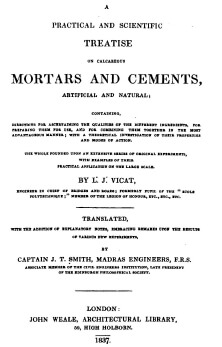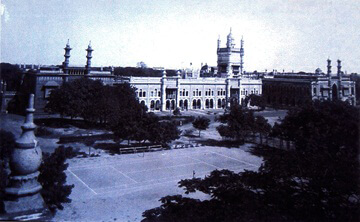Registered with the Registrar of Newspapers for India under R.N.I 53640/91
Vol. XXIX No. 21 , February 16-29, 2020
The Madras Answer to Marble
by Dr. A. Raman
(Continued from last fortnight)
An incredible input Smith – the builder of the second lighthouse – is the translation of Louis-Joseph Vicat’s Résumé des Connaissances Positives Actuelles sur les Qualités, le Choix et la Convenance Réciproque des Matériaux Propres à la Fabrication des Mortiers et Ciments Calcaires suivi de Notes et Tableaux d’Expériences Justificatives (1828, l’Imprimérie de Firmin Didot, Paris, pp. 149) into English (Smith 1837, Fig. 6). The translation includes notes and comments on Madras chûnnam, based on experiments he made while stationed in Madras.
During Smith’s time in Madras, extensive stretches of magnesite were discovered in the Chalk Hills, Salem and Tiruchirapalli. The estimates were that magnesite was available plentifully. Measures were already in place to explore these landscapes for use as a ‘cement’ source. Benjamin Heyne (1770–1819), a medical doctor and a noted botanist of India, first discovered the availability of magnesite in the Chalk Hills in the early decades of the 19th Century (Blanford 1865). In 1825, Alexander Macleod of the Madras Army established the hydraulic properties of magnesian limestone found in Salem region and brought that finding to Madras government’s attention. The magnesia cement (Sorel Cement) of Salem magnesite was considered of superior quality (Cotton 1839). This material came into extensive use in India after John Smith experimentally verified its efficiency in construction work (Smith 1837).
 Cover page of the translated edition of Louis Joseph Vicat’s book by J.T. Smith (1837).
Cover page of the translated edition of Louis Joseph Vicat’s book by J.T. Smith (1837).Smith (1837) provides extensive scientific remarks on the physical, chemical, and engineering aspects of chûnnam used in Madras. The following paragraph refers to some of his key remarks.
“Three coats were usually applied. The first coat of 1–1.5 cm thickness, intended as wall plaster, involved the application of a mixture of seashell lime and sand, tempered with jaggery solution. On drying, the second, prepared as a thinner solution was applied with the mixture of well-sieved, powdered seashell lime and fine-white sand. The second and the third coats of chûnnam usually did not include the addition of jaggery solution, because its dull-brownness was considered to tarnish the whiteness of the applied chûnnam-wash. The third, usually the last, coat was polished. The third coat chûnnam was prepared with extreme care. Only the whitest seashells with a small proportion of white sand were used.
The components intended for the third coat were ground in a circular, granite-base channel in which a massive stone roller rolled grinding the chûnnam ingredients to a uniformly smooth, creamy paste. In a bushel (c. 27 kg) of this paste, a dozen eggs, half a pound (0.227 kg) of ghee (clarified butter), and some freshly curdled yoghurt (quantity not specified) were added. To this composite, some of the master masons (maistry) added 110–225 g of balapong (soap-stone, steatite, metamorphic talc-schist), which ensured brilliance of the final coat. However, every master mason had a recipe of his own. The essential ingredients, in addition to the lime and sand, were the albumen of eggs and the ghee. Sometimes an oil (not identified) was used instead of ghee. The final coat was always thin, and was applied usually before the second was fully dry. Because of the dilution and thinness, the third coat dried quickly. The washed walls were then scrubbed using the smooth surface of a hand-held block of either balapong or agate. This procedure was done for several hours followed by wiping with a soft cotton fabric.”
In the ‘Memorandum of experiments upon the influence of jaghery in chunam’ published (1839), Smith describes his experiments to establish the validity of using jaggery solution as a tempering agent while making the Madras chûnnam. He made six trials of mixing the mortar with (i) plain water, (ii) fresh-lime solution, (iii) ¼lb (113 g) of jaggery mixed in 1 gallon (3.78 L) of limewater, (iv) ½lb (227 g)of jaggery mixed in 1 gallon (3.78 L) of limewater, (v) 1 lb(453 g) of jaggery mixed in 1 gallon (3.78 L) of limewater, and (vi) 2 lbs (907 g) of jaggery mixed in 1 gallon (3.78 L) of limewater. He concludes that the use of jaggery as an additive to the chûnnam mortar is of special advantage, especially at the first hardening.
He concludes that the jaggery is a highly useful material that acts as an efficient cohesive material in achieving a superior level of compaction of the chûnnam mortar, by enhancing the combining affinity of the lime. The proportion of jaggery used is indicated by Smith as follows (p. 129): ‘no less than 10–20 lbs (4.53–9.07 kg) of jaggery per parrah2 (of chûnnam mortar) is necessary’. On the cohesive property of jaggery he says (p. 129):
‘The reason is, that the improvement made in the cohesion of the cement (mortar) depending only on the quantity of jaghery (jaggery) which remains within it after drying, must obviously be determined by the degree of saturation of the fluid of admixture, which regulates the quantity of the sugar which is left behind on desiccation’.
Conclusion
The remark that repeatedly occurs in the literature on Madras chûnnam is its marble-like finish. Almost every European, who had occasion to see and feel the chûnnam work in Madras consistently admired for its finished quality. Indeed, chûnnam was used in other parts of India for ages. However, the Madras chûnnam was considered marvellous. The Madras chûnnam was the material of choice in building works in Singapore of the Straits Settlements in the early- and mid-19th Century.
The above narrative brings to light some of the ignored, forgotten details of the plastering materials used in the 18th and 19th century Tamizh country, which impress as a giant leap in construction work, further to impressive sculpture work done using different rock materials. The Airawatéswara temple, 4 km south-west of Kumbakonam, built by Raja II (1146–1172 AD) of the later Çola Dynasty will be one example. Another example is the main deity (mûlavar) of ananta-sayana Mahã Vishnu in Sri Ranganãthã temple, Srirangam, near Tiruchirapalli, which is not made of granite as in temples dedicated to Mahã Déva (Siva) in southern India, but of stucco — a unique combination of chûnnam and baked bricks, plastered with a specially prepared balm (Tailam) consisting of musk, camphor, honey, jaggery, and sandal. That apart, for human residences, they used sophisticated technology in making the chûnnam and using that in the most appropriate manner.
Today, many construction engineers and architects debate on the validity and utility of using lime mortar embellished with plant fibres and plant extracts and supplemented by traditional practice of grinding.
The chief engineer of the Public Works Department of Government of Tamil Nadu, referring to the restoration of an iconic building in Madras city — the Hûmayûn Mahal — remarked in The Hindu dated 21 September 2019:
‘We are planning to use bulls to churn lime mortar instead of a mixer, for better compressive strength and long-lasting life. We found that structures built with lime mortar achieved more strength as they grew older, compared to concrete buildings that gained strength only up to 50-60 years.’
 The Humayun Mahal.
The Humayun Mahal.1. Joseph LouisVicat (1786–1861) an engineer in Paris published extensively on the suitability of various limestones for the production of lime. He found that a mortar with hydraulic properties should include lime and either silica or alumina. He invented the method of testing the hydraulic properties of mortar, using the Vicat needle, which measured the setting time of mortars, used even today.
2. Parrah (read as ‘parã’) was a capacity measure widely used in South Malabar until recent times. One para equalled approximately 40 lbs of the measured item (Galletti et al., 1911, p. 42).
(Concluded)

